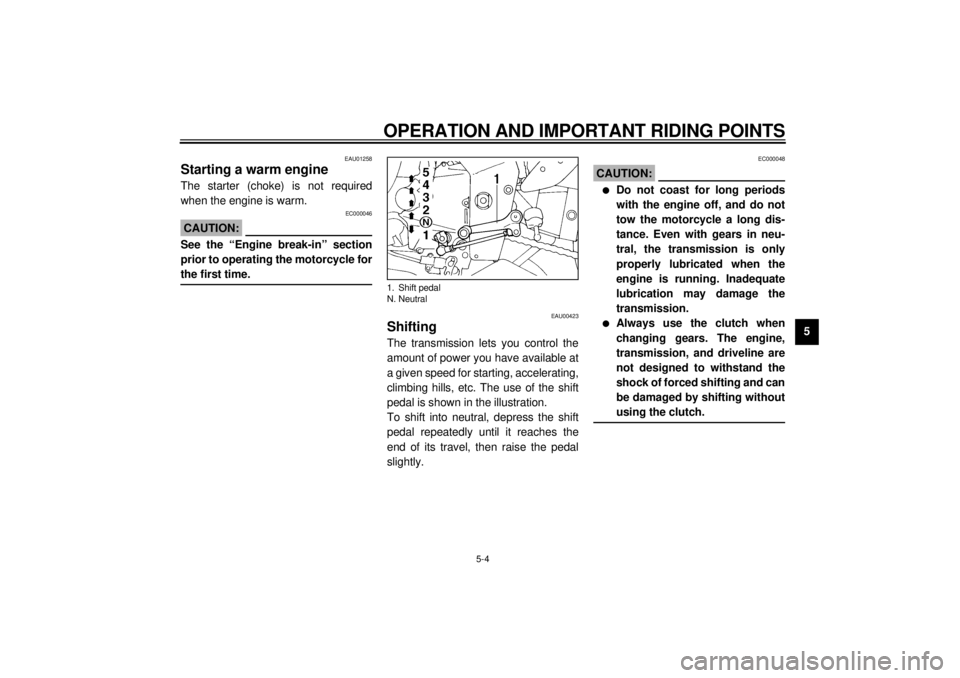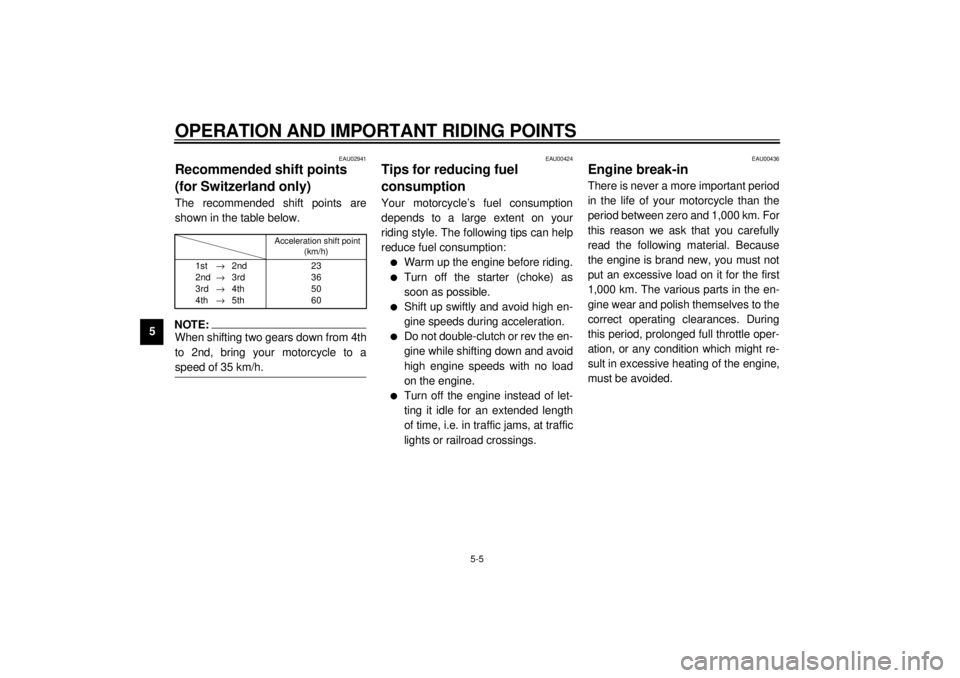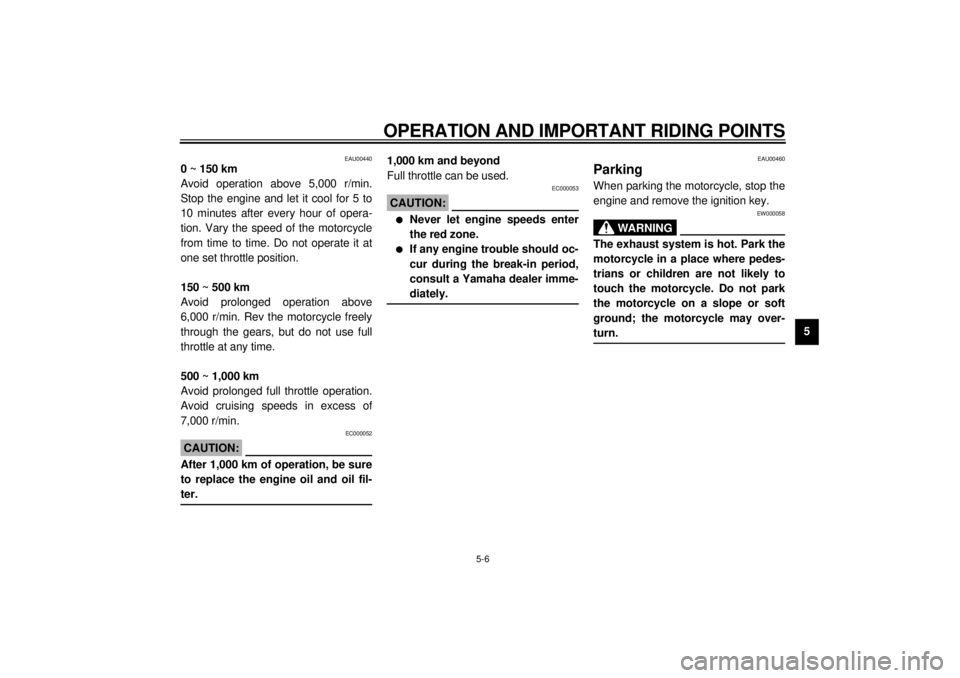2000 YAMAHA YZF1000 engine
[x] Cancel search: enginePage 43 of 103

OPERATION AND IMPORTANT RIDING POINTS
5-3
51. Turn the main switch to “ON” and
the engine stop switch to “ ”.
EC000035
CAUTION:@ If the fuel indicator light comes on,
check the fuel level. If necessary, fill
the tank with fuel. @2. Shift the transmission into neutral.NOTE:@ When the transmission is in neutral, the
neutral indicator light should be on. If
the light does not come on, ask a
Yamaha dealer to inspect it. @3. Turn on the starter (choke) and
completely close the throttle grip.
4. Start the engine by pushing the
start switch.
NOTE:@ If the engine fails to start, release the
start switch, wait a few seconds, then
try again. Each attempt should be as
short as possible to preserve the bat-
tery. Do not crank the engine more
than 10 seconds on any one attempt. @
EC000036
CAUTION:@ The oil level indicator light and fuel
indicator light should come on when
the start switch is pushed and
should go off when the start switch
is released. If the oil level indicator
light flickers or remains on, immedi-
ately stop the engine and check the
engine oil level and for oil leakage. If
necessary, fill the engine with oil
and check to see that the oil level in-
dicator light goes off. If not, consult
a Yamaha dealer. @
5. After starting the engine, move the
starter (choke) to the halfway posi-
tion.NOTE:@ For maximum engine life, never accel-
erate hard with a cold engine! @6. After the engine is warm, turn off
the starter (choke) completely.NOTE:@ The engine is warm when it responds
normally to the throttle with the starter
(choke) turned off. @
E_4sv_Operation.fm Page 3 Tuesday, August 31, 1999 3:45 PM
Page 44 of 103

OPERATION AND IMPORTANT RIDING POINTS
5-4
5
EAU01258
Starting a warm engineThe starter (choke) is not required
when the engine is warm.
EC000046
CAUTION:@ See the “Engine break-in” section
prior to operating the motorcycle for
the first time. @
EAU00423
ShiftingThe transmission lets you control the
amount of power you have available at
a given speed for starting, accelerating,
climbing hills, etc. The use of the shift
pedal is shown in the illustration.
To shift into neutral, depress the shift
pedal repeatedly until it reaches the
end of its travel, then raise the pedal
slightly.
EC000048
CAUTION:@ l
Do not coast for long periods
with the engine off, and do not
tow the motorcycle a long dis-
tance. Even with gears in neu-
tral, the transmission is only
properly lubricated when the
engine is running. Inadequate
lubrication may damage the
transmission.
l
Always use the clutch when
changing gears. The engine,
transmission, and driveline are
not designed to withstand the
shock of forced shifting and can
be damaged by shifting without
using the clutch.
@
1. Shift pedal
N. Neutral
E_4sv_Operation.fm Page 4 Tuesday, August 31, 1999 3:45 PM
Page 45 of 103

OPERATION AND IMPORTANT RIDING POINTS
5-5
5
EAU02941
Recommended shift points
(for Switzerland only)The recommended shift points are
shown in the table below.CF-25ENOTE:@ When shifting two gears down from 4th
to 2nd, bring your motorcycle to a
speed of 35 km/h. @
EAU00424
Tips for reducing fuel
consumptionYour motorcycle’s fuel consumption
depends to a large extent on your
riding style. The following tips can help
reduce fuel consumption:l
Warm up the engine before riding.
l
Turn off the starter (choke) as
soon as possible.
l
Shift up swiftly and avoid high en-
gine speeds during acceleration.
l
Do not double-clutch or rev the en-
gine while shifting down and avoid
high engine speeds with no load
on the engine.
l
Turn off the engine instead of let-
ting it idle for an extended length
of time, i.e. in traffic jams, at traffic
lights or railroad crossings.
EAU00436
Engine break-inThere is never a more important period
in the life of your motorcycle than the
period between zero and 1,000 km. For
this reason we ask that you carefully
read the following material. Because
the engine is brand new, you must not
put an excessive load on it for the first
1,000 km. The various parts in the en-
gine wear and polish themselves to the
correct operating clearances. During
this period, prolonged full throttle oper-
ation, or any condition which might re-
sult in excessive heating of the engine,
must be avoided.
Acceleration shift point
(km/h)
1st®2nd
2nd®3rd
3rd®4th
4th®5th23
36
50
60
E_4sv_Operation.fm Page 5 Tuesday, August 31, 1999 3:45 PM
Page 46 of 103

OPERATION AND IMPORTANT RIDING POINTS
5-6
5
EAU00440
0 ~ 150 km
Avoid operation above 5,000 r/min.
Stop the engine and let it cool for 5 to
10 minutes after every hour of opera-
tion. Vary the speed of the motorcycle
from time to time. Do not operate it at
one set throttle position.
150 ~ 500 km
Avoid prolonged operation above
6,000 r/min. Rev the motorcycle freely
through the gears, but do not use full
throttle at any time.
500 ~ 1,000 km
Avoid prolonged full throttle operation.
Avoid cruising speeds in excess of
7,000 r/min.
EC000052
CAUTION:@ After 1,000 km of operation, be sure
to replace the engine oil and oil fil-
ter. @
1,000 km and beyond
Full throttle can be used.
EC000053
CAUTION:@ l
Never let engine speeds enter
the red zone.
l
If any engine trouble should oc-
cur during the break-in period,
consult a Yamaha dealer imme-
diately.
@
EAU00460
ParkingWhen parking the motorcycle, stop the
engine and remove the ignition key.
EW000058
WA R N I N G
@ The exhaust system is hot. Park the
motorcycle in a place where pedes-
trians or children are not likely to
touch the motorcycle. Do not park
the motorcycle on a slope or soft
ground; the motorcycle may over-
turn. @
E_4sv_Operation.fm Page 6 Tuesday, August 31, 1999 3:45 PM
Page 48 of 103

6
PERIODIC MAINTENANCE AND MINOR REPAIR
Tool kit................................................................... 6-1
Periodic maintenance and lubrication ................... 6-2
Cowling removal and installation .......................... 6-5
Cowling A.............................................................. 6-5
Cowling B.............................................................. 6-5
Cowling C ............................................................. 6-6
Spark plugs........................................................... 6-7
Engine oil .............................................................. 6-9
Coolant ............................................................... 6-11
Air filter ............................................................... 6-12
Carburetor adjustment ........................................ 6-14
Idle speed adjustment ........................................ 6-15
Throttle cable free play inspection ...................... 6-15
Valve clearance adjustment ................................ 6-16
Tires .................................................................... 6-16
Wheels................................................................ 6-19
Brake light switch adjustment ............................. 6-19
Checking the front and rear brake pads.............. 6-20
Inspecting the brake fluid level............................ 6-21
Brake fluid replacement ...................................... 6-22
Drive chain slack check ...................................... 6-23Drive chain slack adjustment ............................. 6-23
Drive chain lubrication........................................ 6-24
Cable inspection and lubrication ........................ 6-24
Brake and shift pedal lubrication ........................ 6-24
Brake and clutch lever lubrication ...................... 6-25
Sidestand lubrication.......................................... 6-25
Rear suspension lubrication............................... 6-25
Front fork inspection ........................................... 6-26
Steering inspection ............................................ 6-26
Wheel bearings .................................................. 6-27
Battery................................................................ 6-27
Fuse replacement .............................................. 6-28
Headlight bulb replacement ............................... 6-29
Tail/brake light bulb replacement ........................ 6-30
Turn signal light bulb replacement...................... 6-30
Front wheel removal ........................................... 6-31
Front wheel installation ...................................... 6-31
Rear wheel removal ........................................... 6-32
Rear wheel installation ....................................... 6-33
Troubleshooting .................................................. 6-34
Troubleshooting chart......................................... 6-35
E_4sv_PeriodicTOC.fm Page 1 Tuesday, August 31, 1999 3:45 PM
Page 51 of 103

PERIODIC MAINTENANCE AND MINOR REPAIR
6-3
6
11
*Wheel bearings• Check bearing for looseness or damage.
• Replace if necessary. ÖÖ
12*Swingarm• Check swingarm pivoting point for play.
• Correct if necessary.
• Lubricate with molybdenum disulfide grease every 24,000 km or
24 months (whichever comes first).ÖÖ
13 Drive chain• Check chain slack.
• Adjust if necessary. Make sure that the rear wheel is properly
aligned.
• Clean and lubricate. Every 1,000 km and after washing the
motorcycle or riding in the rain
14*Steering bearings• Check bearing play and steering for roughness.
• Correct accordingly.
• Lubricate with lithium soap base grease every 24,000 km
or 24 months (whichever comes first).ÖÖ
15*Chassis fasteners• Make sure that all nuts, bolts and screws are properly tightened.
• Tighten if necessary.ÖÖ
16 Sidestand• Check operation.
• Lubricate and repair if necessary.ÖÖ
17*Sidestand switch• Check operation.
• Replace if necessary.ÖÖÖ
18*Front fork• Check operation and for oil leakage.
• Correct accordingly.ÖÖ
19*Rear shock absorber
assembly• Check operation and shock absorber for oil leakage.
• Replace shock absorber assembly if necessary. ÖÖ
20*Rear suspension relay
arm and connecting arm
pivoting points• Check operation.
• Lubricate with molybdenum disulfide grease every 24,000 km or
24 months (whichever comes first).ÖÖ
21*Carburetors• Check engine idling speed, synchronization and starter operation.
• Adjust if necessary.ÖÖÖ NO. ITEM CHECKS AND MAINTENANCE JOBSINITIAL
(1,000 km)EVERY
6,000 km
or
6 months
(whichever
comes first)12,000 km
or
12 months
(whichever
comes first)
E_4sv_Periodic.fm Page 3 Tuesday, August 31, 1999 3:45 PM
Page 52 of 103

PERIODIC MAINTENANCE AND MINOR REPAIR
6-4
6
* Since these items require special tools, data and technical skills, they should be serviced by a Yamaha dealer.
EAU02971*
NOTE:@ l
The air filter needs more frequent service if you are riding in unusually wet or dusty areas.
l
Hydraulic brake and clutch systems
• After disassembling the master cylinder, caliper cylinder or clutch release cylinder, always replace the brake fluid.
Check the brake fluid level of the master cylinder and clutch release cylinder regularly and fill as required.
• Replace the oil seals on the inner parts of the master cylinder, caliper cylinder and clutch release cylinder every two
years.
• Replace the brake and clutch hoses every four years or if cracked or damaged.
@22 Engine oil• Check oil level and vehicle for oil leakage.
• Correct if necessary.
• Change. (Warm engine before draining.)ÖÖÖ
23 Engine oil filter cartridge
• Replace.ÖÖ
24
*Cooling system• Check coolant level and vehicle for coolant leakage.
• Correct if necessary.
• Change coolant every 24,000 km or 24 months
(whichever comes first).ÖÖ NO. ITEM CHECKS AND MAINTENANCE JOBSINITIAL
(1,000 km)EVERY
6,000 km
or
6 months
(whichever
comes first)12,000 km
or
12 months
(whichever
comes first)
E_4sv_Periodic.fm Page 4 Tuesday, August 31, 1999 3:45 PM
Page 55 of 103

PERIODIC MAINTENANCE AND MINOR REPAIR
6-7
6
EAU01668*
Spark plugsRemoval
1. Remove cowlings A and C. (See
pages 6-5 and 6-6 for removal and
installation procedures.)
2. Remove the spark plug caps.3. Use the spark plug wrench in the
tool kit to remove the spark plugs
as shown.
Inspection
The spark plug is an important engine
component and is easy to inspect. The
condition of the spark plug can indicate
the condition of the engine.
Normally, all spark plugs from the
same engine should have the same
color on the white insulator around the
center electrode. The ideal color at this
point is a medium-to-light tan color for a
motorcycle that is being ridden normal-
ly. If one spark plug shows a distinctlydifferent color, there could be some-
thing wrong with the engine.
Do not attempt to diagnose such prob-
lems yourself. Instead, take the motor-
cycle to a Yamaha dealer. You should
periodically remove and inspect the
spark plugs because heat and deposits
will cause any spark plug to slowly
break down and erode. If electrode ero-
sion becomes excessive, or if carbon
and other deposits are excessive, you
should replace the spark plug with the
specified plug.1. Spark plug cap (´ 4)
1. Spark plug wrench
Specified spark plug:
DR8EA (NGK)
X24ESR-U (DENSO)
E_4sv_Periodic.fm Page 7 Tuesday, August 31, 1999 3:45 PM